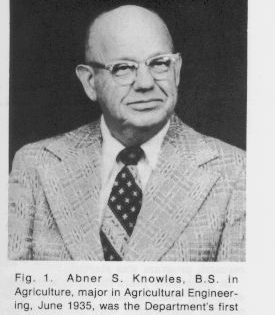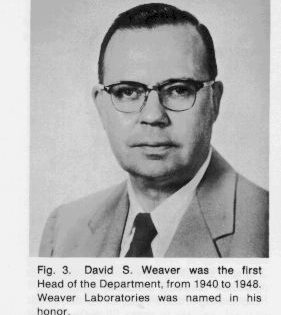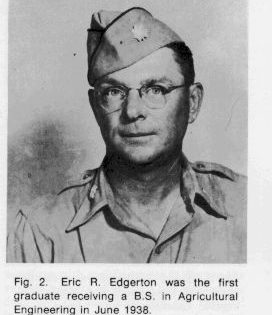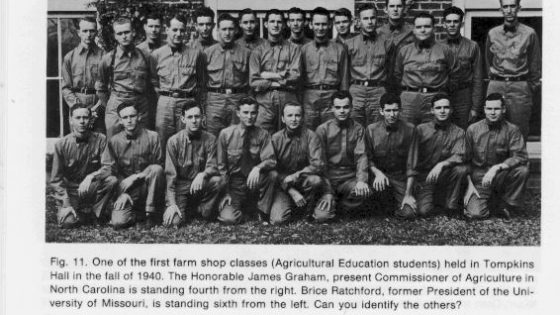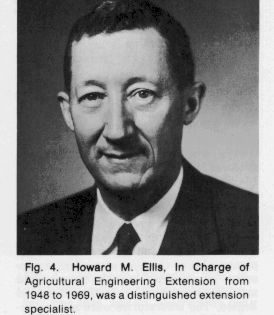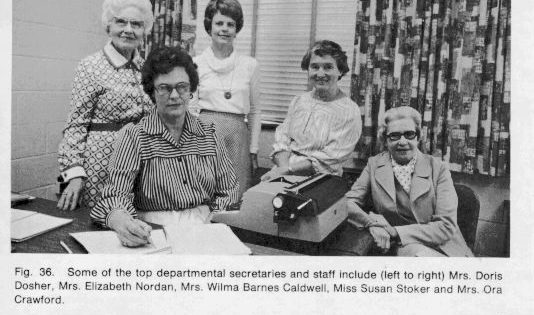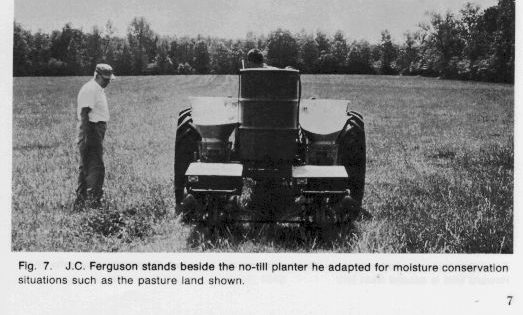Chapter 1
A Department Grows to Maturity
Chapter I – THE EARLY YEARS
Introduction
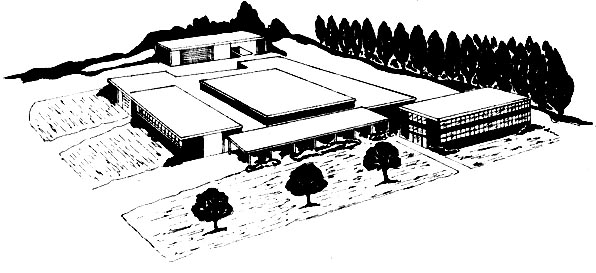 Parting from its roots in Agronomy. The department is officially established as Agricultural Engineering. New students taking a 4-year program leading to a BS degree began to graduate from the Agricultural Engineering Department which is today known as Biological and Agricultural Engineering.
Parting from its roots in Agronomy. The department is officially established as Agricultural Engineering. New students taking a 4-year program leading to a BS degree began to graduate from the Agricultural Engineering Department which is today known as Biological and Agricultural Engineering.
Professional engineering applied to agriculture at what was then North Carolina College of Agriculture and Mechanic Arts (Now N. C. State University) started in extension around 1914. Later, in the early 20s professionally recognized teaching was carried out and lastly, about 1940, a research program was started.
In those early years the three activism extension teaching and research in Agriculture Engineering were not closely coordinated administratively. Both Extension and Experiment Station work started with the State Department of Agriculture but was later moved to campus. Today they are all under the Head of the Department and in one building, Weaver Laboratories, named after one of the professions distinguished leaders and to whose wife this history is proudly dedicated. It is called the Department of Biological Agricultural Engineering more in keeping with its uniqueness, expanding role and responsibilities.
Our First Engineers
H. M. Lynde and F. R. Baker were the first professional Agricultural Engineers, starting in 1913-14. Lynde was Drainage Engineer and Baker, Assistant Drainage Engineer. Such a start was natural since the drainage difficulties, particularly in eastern North Carolina, along with those associated with the construction of rural roads were undoubtedly some of the State’s major problems. These two men were listed in the College catalog among a group identified as employees of the N. C. Agricultural Experiment Station and N. C. Agricultural Experiment Station and N. C. Agricultural Extension Service. It is believed that their work was wholly extension as it is defined today. Their work was in cooperation with the Office of Roads and Rural Engineering of USDA. F. D. Bartel replaced 1918-19. A year earlier E. R. Raney was added as an Extension Farm Machinery Specialist, the first recognition of the latter’s need. Bartel remained on the extension staff in to the 20s. He left to accept a position as Chief Engineer of the Penny Farms in Florida.
Starting around 1918 there were some service courses in farm equipment taught by Professor of Agriculture C. L. Newman in the Department of Agronomy. Newman had B.S. and M.S. degrees from Alabama but apparently was not an engineer. Also at that time Agricultural Drawing, Shop Work and Gas Engines were taught in Mechanical Engineering; Farm Drainage in the Department of Soils.
The Instructional Program
The instructional program really got underway in fiscal 1920-21. R. E. Bosque, possessing a B.S. in Agricultural Engineering. H. D. Lewis, with a B.S. degree in Agricultural Engineering from Mississippi Agricultural and Mechanical College, filled a newly created position of Instructor. Then in 1922 C. R. Bohanan was honored as a Instructor. He held a B.S. degree in Agriculture from the University of Georgia.
During the formative years, and even up to the early 40s the instructional program, and later a very modest research program, was a section in the Department of Agronomy. Actually a 4 – year specialized course in Agricultural Engineering was offered in 1920-21 but attracted no students for several years A total of 10 courses were offered in the 4 – year program covering a wide range of subjects such as Farm Machinery, Farm Survey, and Terracing, Farm Buildings and Concrete, and Farm Engines. Graduates received a B.S. In Agricultural Economics, Forestry and Landscape Architecture. This policy was consistent generally with other land grants colleges and explains why many of the early Agricultural Engineers held degrees in Agriculture, with or without a major in Agricultural Engineering.
To our knowledge the first student to graduate under this first program, was A. S. Knowles in 1935. See Figure 1. Following graduation, Knowles went into the extension service from which he retired in 1965 after 30 years of service. He was Extension Chairman of Brunswick County for 16 years after serving Wayne and Hoke counties.
In 1936 two more students, George Raleigh McColl and Milford Edmond Aycock, graduated among a total class of 17 in the School of Agriculture. McColl entered the U.S. Army, following graduation, as a private and left as a lieutenant colonel. He served as Assistant Farm Agent in Carawba County, and Superintendent of the Home for Boys near Conover, He passed away in April 1951.
Aycock has earned a distinguished record. Recently retired as Vice-President of the Wachovia Bank and Trust Company, he is today a county commissioner in Wake County. His first job following graduation was in Vance County, surveying terracing lines. The equipment he used was the well-known “Bostrom” level which cost not more than $20 each; the level was designed especially for terracing and similar farm jobs and was used in out resident courses.
The school of Agriculture also offered 2-year courses of study including one for specializing in farm shop and one for mechanics. The catalog stated “with the present condition of shortage and high priced labor, it is realized that the gas engine and tractor must be used…to a far greater extent…” It is interesting to note the even with this early 1920 observation it took about 40 years before North Carolina fully realized that reduced costs, labor and drudgery achieved in part with the use of machines were necessary to keep many agricultural products competitive and in plentiful supply.
Also in 1920 at the request of the United States Veterans Bureau a special rehabilitation short course with a major in farm mechanics was offered for men disabled during the First World War. Its purpose was to prepare former soldiers for farming. No records are available as to those completing these courses of study.
A Master of Agriculture degree course of study was offered in various fields but not in Agricultural Engineering at that time. Our first master’s degree program came in 1948.
Physical Facilities Were Meager
In the early years the extension engineers were located in a building near the capitol but were moved to Ricks Hall on the college campus in the late 20s. The teachers were in Patterson Hall, the main agricultural building. Teaching laboratories, consisting largely of gasoline stationary engines and perhaps a few pieces of farm equipment, were first located in the basement of a building designed for general college shop work and foundry. It exists today under the name of “Park Shops.” This basement laboratory was probably where courses in gas engines were offered by Mechanical Engineering to students in agriculture in the earlier days. In 1924, this equipment was moved into about one third of the basement of Patterson Hall. The college catalog speaks with pride of the farm engines laboratory containing 13 different types of stationary gasoline engines and three farm lighting plants; also of the loan of modern equipment by several branch houses and manufacturers who served this State and region. The laboratories were well equipped with instruments for teaching surveying and terracing. The farm ship was small and rather insignificant. A hand turned post drill for metal work was mounted on the doorway post because of the lack of space. However a rather spacious and well-equipped drafting room was used in teaching farm buildings and related subjects. Although the space was somewhat lacking, the rear entrance during and following a rain was worse. One literally had to walk on a plank to avoid the “pond.”
One interesting sidelight: The courses covered the operation of a hydraulic ram. The ram was device that elevated a portion of a hydraulic ram. The ram was a device that elevated a portion of the water from a flowing stream several hundred feet by using the energy of the remaining water from a flowing stream several hundred feet by using the energy of the remaining water. One wonders if the use of a ram will return to our mountain and piedmont areas due to the shortage and/ or cost of fossil energy. The ram is receiving some attention in India.
D. S. Weaver Joins The Faculty
Important changes occurred during 1924. Two teachers were added, J. B. Bookhardt, his activities and departure. We he was hired at the Associate Professorship level. He held a B. S. degree in Agriculture from Ohio State University in 1920 and served on the faculty there and at Mississippi State College prior to coming to North Carolina. In 1925 he earned an M. S. A. E. here. From that point he embarked on an enviable career that started with pioneering rural electrification, followed by being in charge of all three sections of Agricultural Engineering and later as Head of the Department, separate from Agronomy. He ended his career as Director of the Agricultural Extension Service. He became one of North Carolina’s most distinguished and beloved leaders. Talented in many fields he served on numerous and federal agencies, such as “President of the North Carolina Board Farm Agencies.” He retired as Director of the North Carolina Agricultural Extension Service in 1961 and passed away in 1966. ;In 1970 the Agricultural Engineering Building shown on the cover was dedicated in his name. It is appropriate that in the Bicentennial year on May 14 he was enshrined in the North Carolina Agricultural Hall of Fame-perhaps one of the highest honors that can be bestowed in the field of agriculture. His portrait is shown under Figure 3.
Under Weaver’s leadership Agricultural Engineering advanced steadily. The teaching program was removed as a section in Agronomy and became a full fledged department in 1939-40. A 4 year course of study leading to the Bachelor of Science degree in Agricultural Engineering was started a few years earlier. The first student to graduate under this program was E. R. Edgerton in June 1938. See Figure 2. He entered the U. S Army in 1939 and made it a career, retiring in 1967. He served in many areas including Okinawa and Korea. Among his honors is an Army Commendation Medal with two clusters.
The next school year (1938-39) following Edgerton’s graduation the department was sufficiently string to apply for and receive authorization from the American Society of Agricultural Engineers to establish a Student Branch. The charter members, 16 students are shown and identified in Figure 5.
The new 4-year B.S. program was organized into three general areas of specialization namely: (1) Power and Machinery, including rural electrification, (2) Farm Structures, including sanitation, materials of construction and equipment and (3) Land Reclamation, which included irrigation, drainage, soil erosion control and other forms of mechanical improvement of agricultural lands.
Many of the other departments also began offering B.S programs, however a general curriculum and de and degree in Agriculture continued. The schedule of the various curriculum and degree in various curricula offered in Agricultural Engineering through 1976 and the total students graduating each school year by the type of program is presented in the Table the type of program is resented in Table II in the Appendix. Also an roster of graduates by year and program is presented in Table III. One will note that the kinds and number of programs offered over the years were many and varied, an indication of our growing passion and a willingness to be responsive by trying new approaches.
Bookhardt as well as the preciously mentioned extension staff had departed by 1930, leaving only Weaver. He continued as a full-time teacher handling the courses elected by students in Agriculture and required by those who specialized in Agricultural Engineering. A. T. Holman was employed as an “Extension Specialist in Farm Engineering” for a short period of a year or two at that time.
Extension Excels
We are extremely proud of extension’s leadership in terracing, drainage, irrigation, and farm pond development. All these activities started before what is now known as the U. S. Soil Conservation Service became active in promoting the practices. Our total program involved the concept of soil building as well as conserving.
It all started when E. R. Raney was rehired as Chief Engineer of a soil project of what was then called the Soil Erosion Service. His office was in High Point. In 1934 Raney was employed by N. C. State College and placed In Charge of Agricultural Engineering Extension. He soon needed help and in 1935 employed H. M. Ellis. As Agricultural Engineering Specialist, Ellis, a native North Carolinian, had earned two degrees from N. C. State College; a B. S. Engineering in 1929 and a B. S. in Sanitary Engineering in 1934. In 1934 he was employed by the Soil Erosion Service (original name, changed later) in High Point as Assistant Agricultural Engineer. His portrait is shown in Figure 4.
Under Raney, Ellis helped organize the first county terracing association. They eventually reached 52 in number. He is credited with incorporating the associations for the legal protection of its members, In order to keep busy, farm pond construction was a natural addiction for slack periods. Also in 1935 Ellis started holding meetings with county agents to discuss the various aspects of surface and subsurface drainage. The idea took root and resulted in many field demonstrations. The first two were held in Lenior County and resulted in the formation of a corporation there and the purchase of four carloads of tile. The low bidder and award was an out-of-state manufacturer, causing quite an uproar within North Carolina. Later, ditching by the use of dynamite was an exciting successful effort.
Ellis spearheaded the expansion of sprinkler irrigation from 2,00 acres under irrigation in 1952 to over 80,000 in 1963. In 1956 in reorganization of his accomplishments, he received the Man-of-the-Year Award from the U.S. Sprinkler Irrigation Association.
In the early days of irrigation a gentleman asked Ellis for the brand name of a unit he had seen. He could only remember that the sprinklers went round and round and that the pipe was connected by simply pushing one end in the other. The question was welcome because it was progress. So of all agricultural agricultural engineering?” It was natural since the professional was not as well known as say civil or mechanical.
Ellis started the first Rural Safety Council and program in North Carolina. In 1962 he received a Meritorious Service Award from the National Council for his work. Particularly noteworthy was the farm develop to perfection. This service was started by Raney. The plans were of real benefit to farmers. At that time there were no consulting engineers, nor architects with expertise in the farm area. An educational exhibit of the times that was kept in the teaching laboratory is shown in Figure 6. It is interesting to know that pressure for this work came directly from the county agents. They were expressing a real need.
Special credit for helping to develop the plan service must go to Mrs. D. B Dosher working under D. S. Weaver. At its height the plans numbered about 400. Mrs. Dosher worked on those plans, and general art work not only for Agricultural Engineering but other departments as well. She was endeared in the hearts of all who know her. She always had a kind word and was graciously willing to help anyone with their problems. Most importantly she was a skilled draftsman and artist. She retired in June, 1974 after serving 32 years. She is shown in Figure 36.
Prior to Mrs, Dosher, J. H. Walsh was employed as Extension Architect in 1939. He had a degree in Architectural Engineering from Iowa State College. He came to us from the University of Arkansas where he held a position similar to ours.
One of the developments of all this activity was the publication of an illustrated book of the best 150 available building plans. These were selected from among a total of 1500 supplied by the southern states. It was published by USDA.
R. G. Broaddus was also added as Assistant Agricultural Engineer in 1935. In addition to the terracing program he also worked in the area of farm buildings and water systems. Broaddus also came out if the Hanson County project where he was a camp engineer. This latter job came after he received a B.S.A.E. from Virginia Polytechnical Institute in May 1934. So, Raney respected both Ellis and Broaddus for their work in the conservation program and he bought them to Raleigh for more responsive positions at the first opportunity. Broaddus left the service in 1939 for 1 year to manage a freezer locker plant, returned to extension work and some teaching, later to be Secretary of the State Rural Electrification Program. In 1941 he was called into service as 1st Lieutenant and remained after the war’s end as a career officer.
E. R Raner passed away in 1936 and D. S. Weaver was placed in charge of extension work in Agricultural Engineering. After Weaver took over following Raney’s death J. C Ferguson and D. E. Jones were employed in Extension. Ferguson carried the title of Cotton Gin Improvement Specialist. He had a B/S/ Degree in In-State and came to us from a instructor’s position in Mechanical Engineering.
Reviewing the records during the World War II one gets the impression that it was a very difficult period, to say the least, for the extension faculty. Many personnel changes were necessary. Out of a total six specialists, four were called into military service; Richardson, Ferguson, Baraddus and Jones. Only Weaver and Ellis remained.
J. B. Richardson, Assistant Extension Agricultural Engineer was employed in 1939. Mississippi was his native state and he had acquired his B.S.A.E. from their State College. His M.S.A.E. was earned at Iowa State College. With experience in Mississippi and South Carolina he joined out faculty to work on farm machinery and safety. In 1941, however, he left for military duty. Broaddus was hired to fill the position but after a month or two he too, as indicated earlier, went into military service.
In 1942 two new Extension Specialists were employed, J. O. Blickle and C. L. McCaslan. Blickle had earned his B.S.A.E. and M.S.A.E. at Ohio State University. He came to us after both public and private institutions, the last being on farm machinery with a manufacturer in both USA and Canada. Here he actually occupied Ferguson’s position.
The problems associated with mechanization during the war years were Particularly acute. Machines, repair parts and labor were all in short supply-yet food was a vital need. One of the utterances during the period paraphrased Kipling:
“For the want of a bolt a machine was lost!
For the want of a machine a crop was lost!
For the want of a crop a soldier was lost!
For the want of soldier a battle was lost!
For the want of a battle a victory was lost!”
Blickle was attracted to an extension position at the University of Ohio, in his native state, and departed in 1944.
McCaslan remained with us until he passed away in 1948. Little is on record of his previous experiences but it is believed he came here from Clemson University. We do know that he earned an undergraduate degree, probably in agriculture, at Clemson. McCaslan was concerned with many problems especially in the area of hay drying, farm buildings and cotton ginning. His gin improvement work was Particularly important because it was part of a state-wide multi-discipline program called “The one variety.” The objective was to produce a more uniform and higher quality of cotton fiber.
D. E. Jones was Assistant Engineer in Rural Electrification. He took up the work that Weaver pioneered. Unfortunately Jones had to go into the Navy in 1941. When he returned home he became associated with the National Rural Electrification Authority in Washington D.C.
The next engineer to take up Rural Electrification. He took up the work that Weaver pioneered. Unfortunately Jones had to go into the Navy in 1941. When he returned he became associated with the National Rural Electrification Authority in Washington D.C.
The next engineer to take up the rural electrification extension work was H. J. Rideout, Jr., with a B.S. degree from V.P.I in 1938, who was hired from South Carolina in 1945. He resigned in 1947 to accept the position of Rural Service Manager of the Edison Electric Institute in New York City. Today he is a Senior Vice-President of Carolina Power and Light Co. in Raleigh, North Carolina.
J. C. Ferguson remained with the extension service for 36 years with the exception of a 5-year period in the Armed Services as mentioned earlier. He retired in 1966 but has continued to serve the Department in numerous ways. During the 1936-41 period mechanization began to work part time with an agronomist in promoting side placement of fertilizer simultaneously with the planting of fertilizer cotton and corn. They used a two-horse-drawn “Iron Age” planter carried from one demonstration to another in a utility trailer. This citation is another in an enviable record of interdisciplinary in an enviable record of interdisciplinary projects that distinguished Agricultural Engineering over the years.
One day during the transition period following prohibition Ferguson, as a cotton gin specialist, was returning late at night with a small cast iron replica of a cotton gin, when he was stopped by a patrolman and was asked what made the back end of his car sag. “Just a little gin” came the reply. “Let’s see it,” said the officer. Where upon the officer not only saw another kind of gin but a free lecture on how to improve cotton gins. One of Ferguson’s major contributions, and it came after he retired, was the adaptation of equipment for no-till planting. This was part of the total effort to shift to moisture and energy conserving systems. Some estimates are that within the next five or 10 years more than 50 percent of the corn acreage in North Carolina will be planted with this type of practice. Figure 7 shows Ferguson with one of his early adoptions being used to plant in heavy pasture sod.
It can be said that in the earlier years of our growth the extension work was really on-going and outstanding. It was out pride and joy and covered a very wide range of programs. Figure 8 shows some of these undertakings. [Chapter 2]

